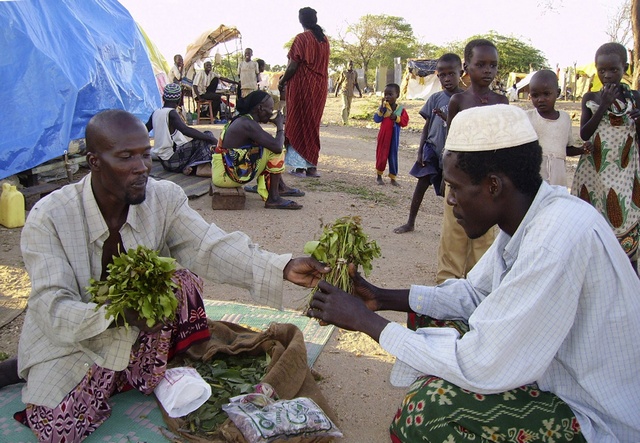Khat, qat, Catha edulis
Herb Here,
Travelling East by the wave of internet surfing I transport to East Africa. Here, I learn of Khat, an indigenous medicine from the leaves of the Catha edulis pine. Khat is used traditionally by peoples of Ethiopia, Yemen, and Somalia. However, recent popularization of the drug by East African and Yemenite immigrants to Europe and America have led politicians, scientists, and the immigrants, themselves, to question whether use of Khat is traditional to their culture or a symbol of a displaced connection to their countries of origin.

Khat refers to the leaves of the Catha edulis tree that grows naturally in the hills of Ethiopia. In Ethiopia, among indigenous peoples, like the Zay, Tigrey, and Shanqella (just to name a few of the many peoples indigenous to Ethiopia), traditional medicines are practiced with the natural flora and fauna of the region. There are many instances in Traditional Environmental Knowledge being passed among these people, although traditional knowledge systems are beginning to disappear due to Western influence and environmental degradation.

The traditional medicine systems are holistic so they encompass treatment of physical, mental, and spiritual ailments. Khat, is primarily used to treat mental ailments and works like an amphetamine. In fact, some modern amphetamines contain cathinone and cathine, the active compounds in Khat that produce the stimulant effects. Khat is used traditionally to help farmers work on their crops, help elders concentrate during judicial meetings, intensify religious prayers to Allah, cure obesity, and bring euphoria to social gatherings. In Yemenite culture especially, Khat is central to social gatherings and has been used recreationally since the 17th century. Khat is usually rolled up in banana leaves and chewed. The juices excreted are absorbed in the saliva while the resin is spit out, like chewing tobacco. The individual begins feeling the effects about an hour later.
Khat causes many social interactions, as it is here in this trade between two Ethiopean men
Recently, Khat has come under fire for its use by immigrants from Somalia, Yemen, and Ethiopia in European countries and America. The euphoric effects of Khat is generally what worries officials and no studies have linked the drug to crime. Some immigrants consider regulation of Khat unjust because the drug links the immigrants to the tradition of their home countries. For Yemenites, Khat is a focus of social gatherings and causes unity among them. Still for other immigrants, especially Somali immigrants, use of the drug is malevolent to their communities. Though some Somali argue Khat is traditional to their homeland, many do not believe it is traditional; instead Khat is a drug that was exported in Somalia during Somali labor on roads in Ethiopia for European expansionists. Because the Khat is relatively cheap, Somali immigrants argue that instead of creating a community Khat destroys the community through poverty. The Somali government has even banned Khat from use in Somalia.

Khat is becoming regulated in many European countries
There are two sides to modern uses of Khat. First, Khat can often be a symbol of home for traditional peoples who were displaced from their home countries, which constructs community in new countries. With this in mind, government regulation stems from a lack of cultural understanding. Still, there is the argument that the traditional uses of Khat are false traditions. This illustrates a degradation of TEK because as indigenous peoples are displaced from their homelands, their traditional knowledge becomes abused and not practiced among the peoples.
Herb on,
Herb (Danielle)
Websites:
 Hey this entry will be a little bit off from Asia but by not so much =). I have found another indigenous medicinal plant that was so abundant that I could not passed them by without mentioning them. The region where I found another plant to introduce is Australia especially central and northern Australia where traditional medicine is still practiced by tribal aborigines. When I went down to Australia from all the way from Siberia, I was wondering what kind of plants would be there, should I just head back to home and rest? But when I reached there I was struck with surprise with the abundance of medicinal plant that this country have.
Hey this entry will be a little bit off from Asia but by not so much =). I have found another indigenous medicinal plant that was so abundant that I could not passed them by without mentioning them. The region where I found another plant to introduce is Australia especially central and northern Australia where traditional medicine is still practiced by tribal aborigines. When I went down to Australia from all the way from Siberia, I was wondering what kind of plants would be there, should I just head back to home and rest? But when I reached there I was struck with surprise with the abundance of medicinal plant that this country have. Although I had in mind how indigenous people are full of knowledge with organisms around them, when I found that all members of the indigenous family knew their medicinal plants, their location, structure, values and their application, I was stunned once more. Now let’s direct our attention to one of medicinal plants.
Although I had in mind how indigenous people are full of knowledge with organisms around them, when I found that all members of the indigenous family knew their medicinal plants, their location, structure, values and their application, I was stunned once more. Now let’s direct our attention to one of medicinal plants. Now that concludes our time in Australia. I will be back when there are any more interesting medicinal plant comes across my travel.
Now that concludes our time in Australia. I will be back when there are any more interesting medicinal plant comes across my travel.

















